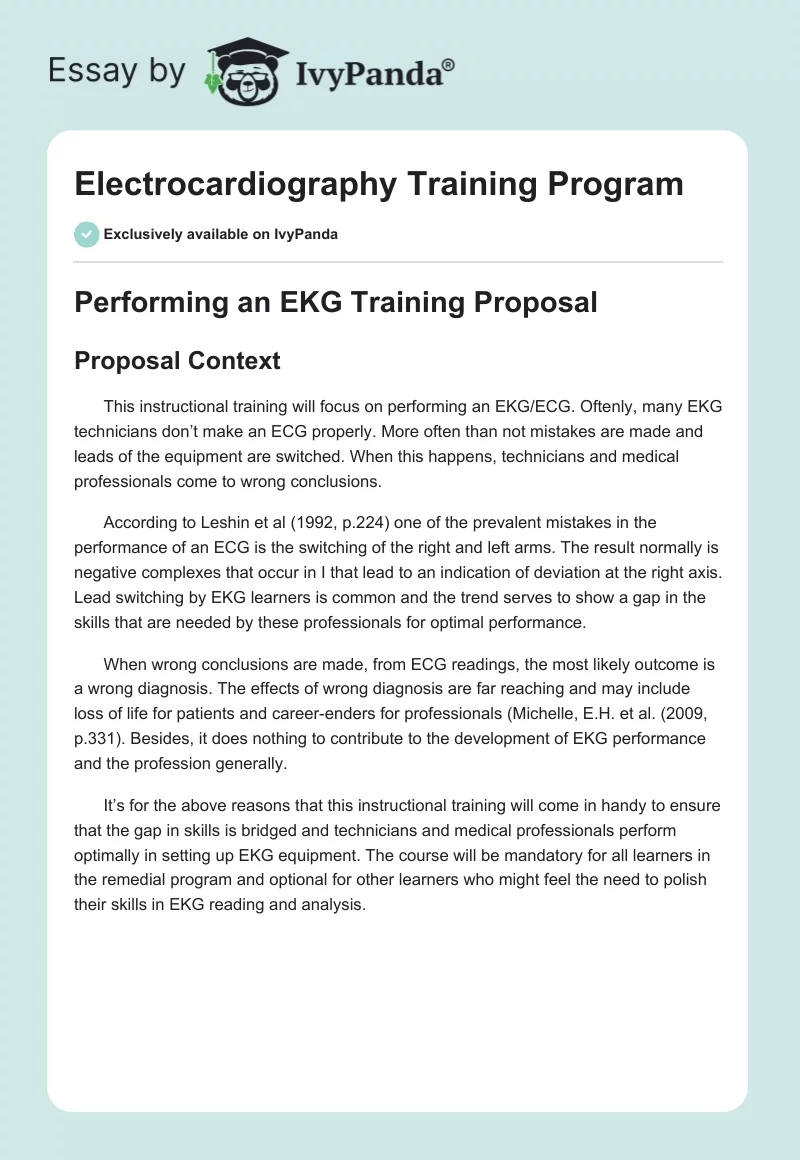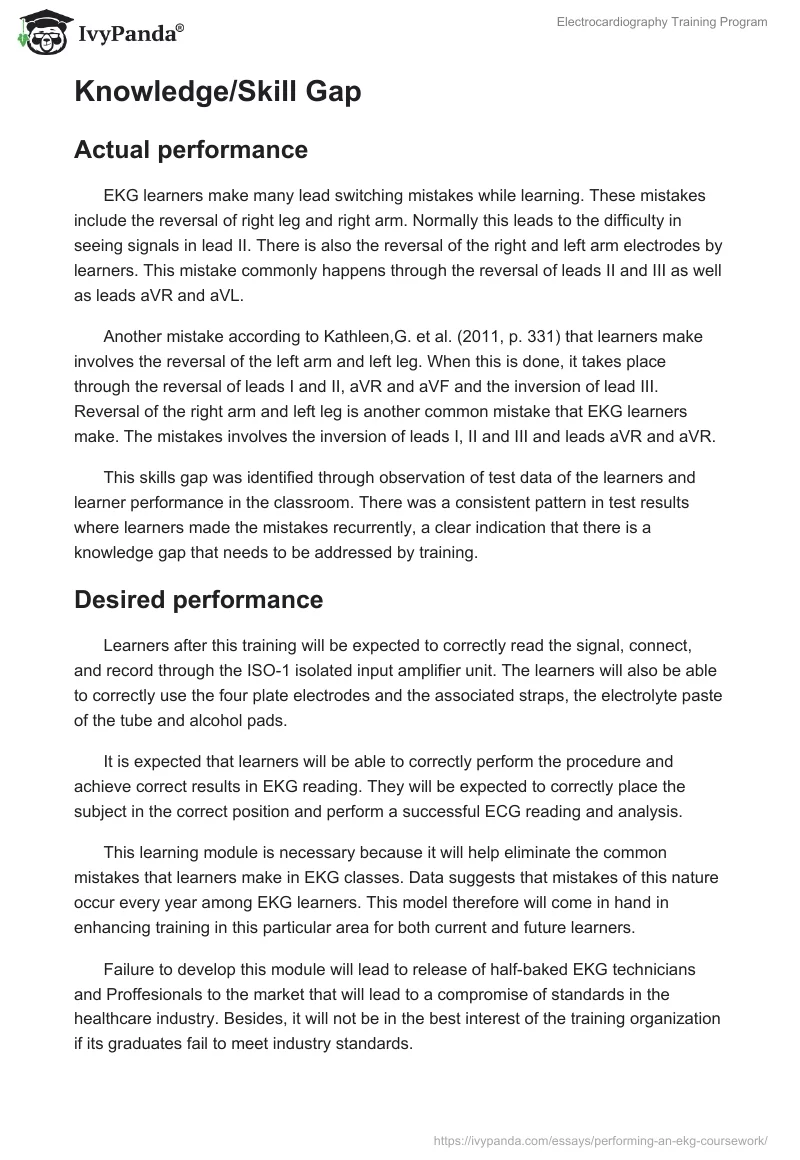Performing an EKG Training Proposal
Proposal Context
This instructional training will focus on performing an EKG/ECG. Oftenly, many EKG technicians don’t make an ECG properly. More often than not mistakes are made and leads of the equipment are switched. When this happens, technicians and medical professionals come to wrong conclusions.
According to Leshin et al (1992, p.224) one of the prevalent mistakes in the performance of an ECG is the switching of the right and left arms. The result normally is negative complexes that occur in I that lead to an indication of deviation at the right axis. Lead switching by EKG learners is common and the trend serves to show a gap in the skills that are needed by these professionals for optimal performance.
When wrong conclusions are made, from ECG readings, the most likely outcome is a wrong diagnosis. The effects of wrong diagnosis are far reaching and may include loss of life for patients and career-enders for professionals (Michelle, E.H. et al. (2009, p.331). Besides, it does nothing to contribute to the development of EKG performance and the profession generally.
It’s for the above reasons that this instructional training will come in handy to ensure that the gap in skills is bridged and technicians and medical professionals perform optimally in setting up EKG equipment. The course will be mandatory for all learners in the remedial program and optional for other learners who might feel the need to polish their skills in EKG reading and analysis.
Knowledge/Skill Gap
Actual performance
EKG learners make many lead switching mistakes while learning. These mistakes include the reversal of right leg and right arm. Normally this leads to the difficulty in seeing signals in lead II. There is also the reversal of the right and left arm electrodes by learners. This mistake commonly happens through the reversal of leads II and III as well as leads aVR and aVL.
Another mistake according to Kathleen,G. et al. (2011, p. 331) that learners make involves the reversal of the left arm and left leg. When this is done, it takes place through the reversal of leads I and II, aVR and aVF and the inversion of lead III. Reversal of the right arm and left leg is another common mistake that EKG learners make. The mistakes involves the inversion of leads I, II and III and leads aVR and aVR.
This skills gap was identified through observation of test data of the learners and learner performance in the classroom. There was a consistent pattern in test results where learners made the mistakes recurrently, a clear indication that there is a knowledge gap that needs to be addressed by training.
Desired performance
Learners after this training will be expected to correctly read the signal, connect, and record through the ISO-1 isolated input amplifier unit. The learners will also be able to correctly use the four plate electrodes and the associated straps, the electrolyte paste of the tube and alcohol pads.
It is expected that learners will be able to correctly perform the procedure and achieve correct results in EKG reading. They will be expected to correctly place the subject in the correct position and perform a successful ECG reading and analysis.
This learning module is necessary because it will help eliminate the common mistakes that learners make in EKG classes. Data suggests that mistakes of this nature occur every year among EKG learners. This model therefore will come in hand in enhancing training in this particular area for both current and future learners.
Failure to develop this module will lead to release of half-baked EKG technicians and Proffesionals to the market that will lead to a compromise of standards in the healthcare industry. Besides, it will not be in the best interest of the training organization if its graduates fail to meet industry standards.
Instructional goal
The main drive behind the development of this module is the achievement of consistency in the performance of EKG learners. It’s assumed after the development and implementation, the common mistakes described above will be significantly reduced among learners after the initial training is done.
The module is also expected to eventually identify the leading causes of the mistakes made by learners so that programs can be put in place to address the. Additionally, the program is expected to help learners not in remedial classes to polish and refresh their skill. A proposal will be fronted to the institution for the training module to be made permanent to ensure continued adherence of organizational standards.
Objectives
Terminal objectives
Learners will be tested at the end of the course and they must meet the objectives that will be set before the beginning of the course. Testing will compulsory for remedial learners and optional for others. The objectives include:
- To test remedial learners on the placement of the right leg and right arm to achieve signal reading in lead II. Learners will be graded and one will be deemed to have passed upon achieving the above signal and a score of over 80 accuracy will indicate achievement of consistency
- To test the placement of right and left arm electrodes. Learners will be deemed to have achieved consistency after correct placement of leads II, III, aVR, and aVL. An accuracy score of 80% by remedial learners will indicate achievement of consistency.
- To test the placement of left arm and right leg. Correct placement of leads I and II, aVR and aVF and lead III and a score of over 80% by remedial learners will indicate consistency in the learner.
- To test the placement of the right arm and left leg. Correct placement of leads I,II and III and aVR and aVF and a score of over 80% by the remedial learners will signify consistency
Enabling Objectives
Instructors will be aiming to achieve the above through enabling objectives that will be:
- To teach learners on the correct placement of the right leg and right arm to ensure a signal is occurrence in lead II
- To teach learners on how to avoid reversal of leads I and III as well as leads aVR and aVL that result in incorrect placement of right and left arm electrodes.
- To teach learners on how to avoid reversal of leads II, and I leads aVR and aVF and the inversion of lead III to avoid incorrect placement of the left arm and the left leg.
- To teach learners on how to avoid inversion of leads I, II, and III and also leads aVR and aVF so as to ensure correct placement of the right arm and left leg.
Content and Tasks
The mistakes that have highlighted the knowledge gap in as said before deal with lead switching. The course content therefore will emphasize on the information that the learners will need to make correct connections to avoid switching.
Its important for the learners to be well versed in Cardiac Conduction System Anatomy, cardiac physiology and in the theory of electrocardiography. The content will specifically focus on lead connection and EKG interpretation.
A wide variety of topics will be offered in one moth course that will include information on the administration of EKG and alternate EKG types, indication of EKG and EKG overview. a combination of various instructional methods will be used including text, photography, and other interactive programs that will be used to suit the different learners; preferences.
Presentation will mainly be carried out using the Microsoft PowerPoint and a digital scanner that will necessitate the direct input of EKG.
Learners will be assigned both in groups real life cases where they will be required to input their skills on EKG performance. At the end of every session the lesson content will be distributed to the learners through a multimedia on a CD ROM to enable them go through the content to develop perfection.
Target Audience Description
This learning module will be targeting all learners in remedial learning program in the institution. Besides, the program will be open to other learners who will be in need of polishing their EKG skills. A number of factors that will either help or inhibit the rate of understanding or learning of the learners will affect delivery of this program.
Their mental abilities and level of knowledge in the EKG theory will be big factors in learning. Besides there will need to be motivation for the students to help them grasp the concepts that will be necessary for consistent performance of EKG procedures. Additionally, learners will be expected to be well versed in both basic and advanced computer skills that will come in handy in manipulating some EKG equipment and software.
Project Scope
Success of this model will largely depend on the availability of funds. Given the sophisticated type of equipment that is needed for its success and the need for a clear presentation, the module will rely greatly on designers and other information technology components that will only be availed through monetary resources. Considering the institution’s situation financially, the module is likely to be met with financial difficulties.
Presentation will be carried out in PowerPoint presentations using a projector. It will incorporate colored images and vide clips that will help learners to relate with the content of that will be presented. The classes will also include lab sessions where learners will demonstrate their skills.
The sessions will offer a chance for instructors to gauge the level at which learners will demonstrate their theory knowledge to practical. It will assist instructors to ascertain the knowledge gaps and that exists in the approaches the learners use and the actual performance of EKG’s.
Technological Considerations
There will be a lot of technological involvement in the program. Those learners that won’t be well versed in IT will be taken through a short refresher course while course-designing instructors will assist learners in navigating the EKG equipment that will be used for practical purposes.
References
Kathleen,G. et al. (2011). Integrating technology in nursing education: Tools for the knowledge era.Ontario: Jones & Barlette Learning.
Leshin, B.C et al. (1992). Instructional design strategies and tactics. New Jersey : Educational technology Publications.
Michelle, E.H. et al. (2009). Clinical Medical Assisting: A Professional, Field Smart Approach to the workplace. New York: Cengage Learning.


